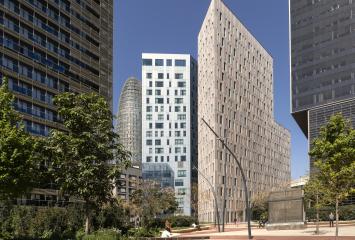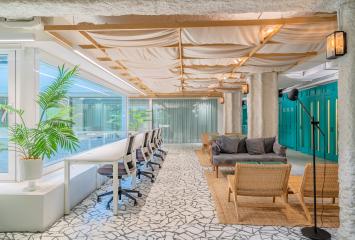Inclusivity as an Essential Ingredient of the Contemporary Office
In our blog, we have dedicated many articles to exploring the possibilities of sustainability in contemporary offices. After all, it is a quality that companies increasingly demand for their spaces due to both environmental commitment and social reputation. However, the new office, the office that is emerging as the archetype for the coming decades, is much more than an office that consumes the least possible resources and minimizes pollution. It is (or should be) an inclusive office that takes into account the variety of abilities among people. It is an accessible office. And it is so thanks to various measures:
Removal of Architectural Barriers
Inclusivity in the office begins in the architectural development of the building. This is where the variety of mobility abilities must be taken into consideration, and spaces should be planned to be free of physical barriers that obstruct access for those with reduced mobility. This includes not only prioritizing spacious areas but also using ramps, handrails, and properly located elevators. It is an exercise that requires a combination of empathy and architectural knowledge.
Creation of Accessible Spaces
Another important aspect of inclusivity in the office is the development of strategically accessible spaces so that people with reduced mobility can meet all their needs. Bathrooms are an example, which must be designed with the highest accessibility standards in mind. Parking spaces are also crucial. They need to be created in convenient locations close to elevators, along with proper signage to prevent disorientation or confusion.
Adaptable Work Materials
Individuals with diverse abilities sometimes require versatile and adaptable work materials that allow them to configure them for their benefit and comfort. This includes ergonomic chairs, height-adjustable desks, and adjustable lighting equipment, among many other things. It is also essential to consider the diversity of abilities when selecting computer devices and software used in daily work. All of these should take an inclusive approach.
Clear General Signage
The modern office, increasingly driven by a human-centric approach, encompasses flex spaces, enclosed workspaces, meeting rooms, VIP areas, cafeterias, rest areas, terraces, parking, bathrooms, and often many more spaces. In this regard, the pursuit of inclusivity requires clear and easy-to-understand signage with large letters and contrasting colors to facilitate orientation for individuals with visual or cognitive disabilities.
Flexibility of Spaces
One of the characteristics of the cutting-edge office is replacing the rigidity of spaces with much greater flexibility, allowing organizations to adapt rooms to their changing needs and providing employees with greater freedom of movement for increased comfort and satisfaction. This also has significant benefits for integrating individuals with diverse abilities, as it allows companies to address their demands for physical inclusivity and make changes to spaces to meet their needs.
Beyond Architecture and Design
Space configuration should be the foundational step in promoting inclusivity in an office. However, once physical barriers are removed and mobility and the performance of all routine tasks are facilitated, the work must continue in the form of clear communication through simple language and accessible formats, inclusive policies that promote equal opportunities, training for healthy relationships with different abilities, and regular evaluation of the well-being of people with disabilities.
The human-centric perspective is a reality not only in office buildings but also in public and private organizations. And that "human" includes all of us, regardless of the type of abilities we have. Therefore, inclusion efforts should not be limited to the goal of integrating people with different abilities; it is essential to empower them to grow, realize their full potential, and evolve within the office environment. Progress depends on all available talent.

